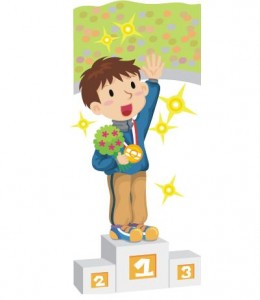
The following poem is my adaptation of one written by Lucy, an 8 year old poet whose poem won one of my poetry competitions. Her poem was so effective and full of figurative language (including alliteration, metaphors and personification) that it made me want to see these fabulous animals.
[click to continue…]
 The following poem was written by 8 year old Lucy,a winning poet from one of my school competitions. I chose it because it uses some fantastic poetic techniques such as alliteration, assonance, metaphors, as well as including rhyme and near rhymes. More importantly, the poem made me want to ‘meet the lemurs’ and I could understand their appeal because of the fabulous imagery that Lucy used. The only advice I could offer to this very clever young poet was on how to achieve a consistent rhythm, and how that would affect the poem, and she was gracious enough to allow me to revise her poem as a teaching aid to anyone who would like to understand about rhythm poetry and how to edit a poem to achieve a consistent rhythm without losing the context or content. This is the result……..
The following poem was written by 8 year old Lucy,a winning poet from one of my school competitions. I chose it because it uses some fantastic poetic techniques such as alliteration, assonance, metaphors, as well as including rhyme and near rhymes. More importantly, the poem made me want to ‘meet the lemurs’ and I could understand their appeal because of the fabulous imagery that Lucy used. The only advice I could offer to this very clever young poet was on how to achieve a consistent rhythm, and how that would affect the poem, and she was gracious enough to allow me to revise her poem as a teaching aid to anyone who would like to understand about rhythm poetry and how to edit a poem to achieve a consistent rhythm without losing the context or content. This is the result……..
Meet the Lemurs at
Yorkshire Wildlife Park
by Lucy aged 8
Lively, leaping lemurs
jumping from tree to tree
Furry acrobats
performing for all to see
Stripy tails flying
through the branches
Oh look at those
fancy dancers
Pointy faces peeping
through the leafy trees
As they rest their paws
on their furry knees
Walking the tightrope
with the greatest of ease
As their long fluffy tails
sway in the breeze
A walk in lemur woods
I would recommend
If you want to meet
lots of new furry friends. |
|
Meet the Lemurs at Yorkshire Wildlife Park
by Lucy aged 8, revised by Angela Yardy to
include a strict rhythm (Iambic Heptameter)
Come see the lively, leaping lemurs
jump from tree to tree
These furry acrobats perform
for everyone to see.
Above, the stripy tails fly
through branches all around
Those fancy dancers prancing
as we watch them from the ground
Their pointy faces peeping through
the green and leafy trees
Meanwhile they rest their fingered paws
upon their furry knees.
They walk the tightrope without thought,
and with the greatest ease
Their long and fluffy tails swaying
gently in the breeze.
A walk in lemur woods is something
I would recommend
If you would like to meet this band
of special furry friends. |
When you look closely, the entire content of the poem is exactly the same; I have neither added nor taken away any details, but have just changed the order of the words or lengthened sentences to fit a specific metre (rhythm) called the Iambic Heptameter (it sounds like a clever, showy phrase, but it’s simple to understand if you look at this link on rhythm poetry to understand about specific metres.) In basic terms, the ‘iambic’ refers to the bounce of the rhythm (in this case each ‘foot’ goes ‘Di Dum’, with the stress on the second syllable), and the ‘heptameter’ refers to how many of those ‘feet’ are repeated on one line (ie, hept=7), but my teaching on rhythm poetry will lead you through it step by step (quite appropriate as rhythm poetry is measured in ‘feet’!)
USEFUL TIP: Notice that each line in my revised version is longer than the original. I often find that it is easier to edit poems with longer lines, because it is easier to add ‘filler’ words like ‘quite’, ‘maybe’ ‘really’ etc to keep the rhythm consistent than it is to remove words which may be crucial to the content and context of what you want to say. With shorter verses and lines compromises sometimes have to be made when the preferred words cannot feasibly fit.

Winning Poems about children who worked down the mines in Victorian Britain, by Fitzwilliam Primary School
Following a visit to the National Coal Mining Museum I spent an excellent morning doing a poetry workshop with a mixed class of year 3 and 4 pupils doing poems on the topic of mining. We focussed particularly on the experiences of the poor Victorian children in Britain who were forced to work down the mines, and tried to imagine the life they would have led. The visit helped immensely as poetry is so much about experiencing and feeling what you write, and so we used the senses as our focus to help us to think of things to write about. [click to continue…]
 For me personally, my favourite poems tend to have something of the ‘R’ factor. I think of them as the three ‘R’s:
For me personally, my favourite poems tend to have something of the ‘R’ factor. I think of them as the three ‘R’s:
Rhythm
Rhyme
“Ah”
They don’t necessarily need all three, but invariably the ‘R’ factor is there somewhere.
1. Rhythm (or metre)
Whilst I get a natural enjoyment out of writing and reading poems with rhythm, I have only recently begun to realise that there are specific guidelines to poetic metres which can be learnt and which improve the feel of a poem, so I have included a page of basic guidance of Rhythm Poetry to help you achieve the same understanding. I have also gone on to adapt a poem by adding a consistent rhythm , hopefully showing the difference that metre can make to good poetry. The poem is by Lucy, an 8 year old poet who attended one of my poetry workshops, and who gave me permission to make her fantastic poem fit a specific metre to see how it could improve it.
(Click here to read her fabulous poem “Meet the Lemurs” and get some tips and a specific example of editing rhythm poetry)
2. Rhyme
You may have noticed that I love rhyming poems. Let’s face it; we are all brought up on them. Rhyme patterns are all around us; in lullabies as babies, nursery rhymes as toddlers, playground chants as we get older, and even football chants when older still! Rhyme is excellent for aiding the memory and adding some predictability, but also to add humour when we avoid the obvious rhyme and slip in something unexpected (see my alternative nursery rhymes). Click on the following link to discover why rhyme is a good thing to encourage in children in particular.
3. The “Ah” Factor
With or without rhythm and rhyme, a poem can achieve something special when it connects with the reader’s emotions and deeper understanding. Try saying ‘ah’ in different ways and you’ll realise that it can be an expression of gentle affection, fear, pain, sympathy, surprise, shock, realisation etc. These are all feelings that a good poet can create in the readers, especially by highlighting the use of the senses in their poetry.
Most of all though, I love a poem that makes me say “Ah yes; I’ve never noticed that before, but it’s true!”
The following senses list poem talks about how the use of rhythm and rhyme can be important in poetry. It includes a small amount of alliteration and assonance, as well as some personification and metaphors.
Feel the music of the rhythm
In your fingers and your toes.
Feel the way the poem bounces
With the rhythm as it flows. |
 |
 |
See the journey
of the rhythm
As it travels
into rhyme |
Hear the clapping
of your hands
As they help you keep in time. |
![clapping[1] clapping[1]](http://angelaspoems.com/wp-content/uploads/2012/06/clapping1_thumb.gif) |
 |
Taste the flavour
of the poem
As the words
trip off your tongue |
Smell the essence
of the message
Now the fun has
just begun…… |
 |
|
Yes, my poem’s just begun
Write your own and have some fun…
|
|
by angela on November 28, 2011

Alphabetical Index (by title)
Every poem I write has some specific purpose.
Some, I have written to teach or demonstrate certain writing techniques to children, others to be used as different examples of specific poem forms, and others simply to challenge myself. On the other hand, many are to express my thoughts, feelings, wonderings, and sense of humour. Like most people, my writing is affected by my mood, as I find poetry very therapeutic.
Every poem therefore, is listed under each appropriate poem category above and can be found according to what technique or poem form it uses or what topic/subject it is about etc. However, if you are looking for a particular poem of mine and know it’s title, just use this alphabetical list below to find it and click on it’s link. I have included all of my poems by title in this index, Christian or otherwise, childish or adult, and can assure you as a parent of high moral standards that NONE OF MY POEMS contain any inappropriate themes for children. [click to continue…]





![clapping[1] clapping[1]](http://angelaspoems.com/wp-content/uploads/2012/06/clapping1_thumb.gif)


